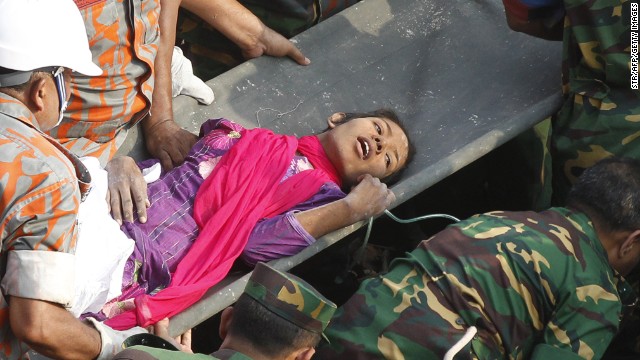Story highlights
- Sanjay Gupta: The pool of water and the air pocket the woman was in were crucial
- Some people can survive without food for weeks, he says
- The body can enter a state known as starvation ketosis
A well-placed pool of water and an air pocket appear to have combined to help a young woman survive for 16 days under the rubble of a collapsed Bangladeshi building.
The woman, who was pulled out Friday from the remains of the garment factory, was found in that pool of water, rescue official Lt. Col. Moazzem Hossain told CNN.
It would have been crucial to her survival, CNN's Dr. Sanjay Gupta said.
The woman, known only as Reshma, 19, was able to use an iron rod to get workers' attention and cry out to them, "I'm alive. Please rescue me," according to Capt. Ibrahim Islam, a Bangladeshi military official outside the recovery operation.
The rescue was a bright spot against the grim recovery. The death toll from the April 24 collapse is more than 1,000.
The woman reportedly was in a partially collapsed room and had access to an air pocket, which Gupta said is "obviously, the most crucial thing."
In addition, "having some access to water must have happened here," he noted.
The source of the pool of water was unclear. Water may have trickled to the building's basement, where Reshma was found, from recent rains and from water sprayed by rescuers. Firefighters had hosed down the area to extinguish a fire that erupted during a failed rescue attempt.
Gupta said the woman likely had some sort of access to food, although people have been known to survive a couple of weeks without it. He said it was "somewhat surprising" that Reshma would have been able to call out to rescuers, as "even that requires a fair amount of energy."
Asked how long someone can survive without food or water, Gupta said, "We keep redefining that a bit."
He recalled the case of Evan Muncie, a then-28-year-old man who was pulled alive from a building in Port-au-Prince, Haiti, about four weeks after a January 2010 earthquake that leveled much of the city. It is believed Muncie had some access to food and water, although details remain murky, he said.
Also, Reshma's youth may have worked in her favor, he said. "The body can be very good at preserving itself."
A body can enter a state known as starvation ketosis, Gupta said, in which it utilizes muscles and other sorts of protein to feed itself.
State-run news agency Bangladesh Sangbad Sangstha (BSS) reported Reshma told her rescuers that she survived on dry food and water that was tossed into the rubble in the first days after the collapse.
"I ate biscuits and water," she told rescuers, according to the news agency, "but the stock dwindled two days ago."
Reshma told doctors at a military hospital, where she was taken, that she was wracked by third for the past two days. She spent the entire time in the dark between floors that had collapsed, according to the BSS report.
While Reshma's outlook is favorable, food will have to be reintroduced slowly, Gupta said, noting that Muncie had lost 30 pounds while buried under the Haitian rubble.
"My guess is, she's extremely weak," he said.











